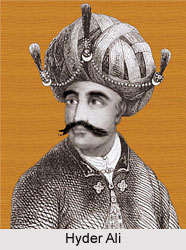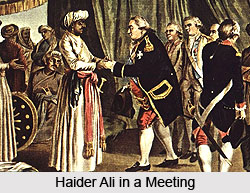 The administrative policies of Hyder Ali were largely indebted to the Mughal policies, especially those of Emperor Akbar. However, further changes were introduced to those policies keeping in mind the interest of the subjects. In fact the agrarian, economic and military policies of Hyder Ali were followed by later administrators in India as well.
The administrative policies of Hyder Ali were largely indebted to the Mughal policies, especially those of Emperor Akbar. However, further changes were introduced to those policies keeping in mind the interest of the subjects. In fact the agrarian, economic and military policies of Hyder Ali were followed by later administrators in India as well.
As per history Hyder Ali"s seizure of power in Mysore was fairly swift. Inter¬vening in the struggle between the raja and his powerful minister Nanjaraj, Hyder Ali"s own patron, Hyder took the side of the raja, who had been chafing at being reduced to a nominal status by Nanjaraj. Replacing the latter, Hyder Ali acquired full power over the state in 1760-1761, but he did not seek to substitute himself for the raja. When the current incumbent (Chik Krishna Raja) died in 1766, he duly installed a successor. The ceremonial of the raja"s court and palace continued to be maintained. Hyder Ali, in fact, looked for the legitimacy of his own power to a different source altogether, one that lay within the framework of the Mughal political system. From Basalat Jang, claimant to the office of the Viceroy of the Deccan, Hyder Ali obtained in 1761 the title of Hyder Ali Khan and the office of "faujdar" of Sira. In this capacity, he could claim to be superior to the Raja of Mysore, whose territory in the better days of the Mughal Empire had belonged to the jurisdiction of that officer. The nominal right to supremacy so gained was strengthened when Sira itself fell into Hyder Ali"s hands later in 1761, followed by the great town of Nagar (Bednur) in 1763. By his conquests in the north and acquisitions in Malabar, Hyder could well claim that he had added territory far larger in size than the original dominions of Mysore that the raja had reigned over.
Internally, Hyder Ali"s regime represented a combination of the existing institutions of the Mysore raj with an entry of Mughal elements. The latter were invoked to increase the state"s share in agrar¬ian revenue and to centralize the administration. Before his time, the local hereditary potentates namely the deshmukhs and palegars ("palaiyak-karars"), and subordinate holders namely the "goudas", "patels" etc. held varied rights and the state"s share in the produce taken in revenue was accor¬dingly much constricted. Hyder Ali took the standard Mughal view that the local dictators were zamindars and as such their entitlements were not revered. He aimed to abolish their intermediation and imposed the land tax directly on the peasants, realizing it through salaried officers. This system, where tax was directly assessed on peasants, came to be the basis of Munro"s Ryotwari system.
Hyder Ali was a brave warrior and his military policies thus formulated aimed at strengthening his forces. The Carnatic wars were a major event in the military career of this Mysore ruler. He was appointed faujdar or commandant of Dindigul in 1753 and actively participated in the wars. This was the occasion to learn much about European methods of fighting: he was deeply impressed. As early as 1755-1756 he is said to have obtained the services of Frenchmen to organize his artillery, arsenal and workshop. The military basis for Hyder Ali"s rapid rise hereafter was based not only on his personal diplomatic skills, but mainly on the armed power he acquired. This lay in a brilliant combination of the mobile cavalry organized on the Mughal pattern with his increasingly disciplined musket-using infantry. Despite some temporary reverses, this combination proved invincible. Undoubtedly, he was the first important Indian commander to realize the value of European methods for drilling infantry, whom he tried to provide with flintlocks, a rare sight so far in Indian armies. This alone makes him a remarkable man.
The economic resources so heavily augmented needed to be centralized. Hyder Ali did not entirely dispense with the Mughal insti¬tution of jagir, the temporary or transferable assignment of tax collec¬tion in a territory in lieu of obligation to maintain a certain number of troops. An order of Tipu Sultan is preserved in which a jagirdar"s obligation to maintain cavalry, with the branding (dagh) of horses, to check their actual maintenance, is referred to in terms that one would have expected from a document of the Mughal imperial administration. But the system of having troops maintained through "jagirdars" was then getting obsolete. The new methods of warfare called for a large standing army. For such an army that had to be directly paid, Hyder Ali had to collect revenues directly and so to limit the extent to which "jagirs" could be assigned. In this he also had well-known Mughal precedents: in 1574-75 Akbar had resumed "jagirs" wholesale in order to obtain better fiscal and administrative control. In the first half of the eighteenth century, the Nawabs of Bengal from Murshid Quli Khan onwards, had also largely dispensed with "jagirs".
 Hyder Ali was, thus, enabled to concentrate resources on improving and enlarging his army by directly collecting revenue in the larger part of his dominions. Unlike the traditional Indian armies with contingents of varying sizes, each depending upon the size of resources of its individual commander, Hyder Ali established the system of "risalas", of a standard number of soldiers with fixed allotments of guns and transport, in line with the pattern of troop division in European armies. Each infantry "risala", for example, was to consist of 1,000 men. The officers of each infantry would be appointed by the ruler himself. This modern organization of the army was accompanied by the creation of regular infantry using European or European-style muskets (flint¬locks). By 1767 he had 8,000 regular infantry so armed, as against 4,000 old-style matchlockmen, plus 5,000 "grenadier" sepoys and 1,000 "topasses (Indo-Portuguese half-castes) with muskets", all in his regular establishment. He continued to employ rocketeers, or persons adept at throwing gunpowder-powered ban rockets, which was a south Indian specialty. He also introduced a local innovation also by having a large bullock-and-cart establishment to enable him to rapidly transport his infantry and supplies. Hyder Ali, however, remained convinced of the importance of cavalry for its tactical mobility. In 1767 he had 800 "excellent Mughal horses" and 12,000 other cavalry. By this year he had 210 Europeans, mostly Frenchmen, serving him, both in the artillery and cavalry. Hyder Ali also tried to develop a navy, which by 1766 comprised 2 ships, 7 smaller vessels and 40 gallivats. He employed a European officer, Stannett, to command the ships when out at sea.
Hyder Ali was, thus, enabled to concentrate resources on improving and enlarging his army by directly collecting revenue in the larger part of his dominions. Unlike the traditional Indian armies with contingents of varying sizes, each depending upon the size of resources of its individual commander, Hyder Ali established the system of "risalas", of a standard number of soldiers with fixed allotments of guns and transport, in line with the pattern of troop division in European armies. Each infantry "risala", for example, was to consist of 1,000 men. The officers of each infantry would be appointed by the ruler himself. This modern organization of the army was accompanied by the creation of regular infantry using European or European-style muskets (flint¬locks). By 1767 he had 8,000 regular infantry so armed, as against 4,000 old-style matchlockmen, plus 5,000 "grenadier" sepoys and 1,000 "topasses (Indo-Portuguese half-castes) with muskets", all in his regular establishment. He continued to employ rocketeers, or persons adept at throwing gunpowder-powered ban rockets, which was a south Indian specialty. He also introduced a local innovation also by having a large bullock-and-cart establishment to enable him to rapidly transport his infantry and supplies. Hyder Ali, however, remained convinced of the importance of cavalry for its tactical mobility. In 1767 he had 800 "excellent Mughal horses" and 12,000 other cavalry. By this year he had 210 Europeans, mostly Frenchmen, serving him, both in the artillery and cavalry. Hyder Ali also tried to develop a navy, which by 1766 comprised 2 ships, 7 smaller vessels and 40 gallivats. He employed a European officer, Stannett, to command the ships when out at sea.
In his army that Hyder Ali tried to introduce as much modernisation as he could, while retaining and developing inherited Indian elements in other spheres of administration. This effort was carried out, however, within a political and ideological framework which was still set by the institutions of the local raj and Mughal fiscal and administrative methods. The administration of Hyder Ali was despotic and centralized and was untouched by any other effort to develop technology and commerce on modern lines. Without this effort, military modernization itself had necessarily to depend heavily on the presence of Europeans, especially the French, and could therefore be expected to be successful only in the short term.
The agrarian administration of Hyder Ali was done in a particular process. After harvest and the taking away of some Petty shares, the heap of the harvested crops was then measured, and divided equally between the government, or renter, and the farmer. But a certain portion is left, which is divided in a particular method. From the entire portion twelve Seers for every Candaca in the heap are measured, of which the accomptant takes one third, and the remainder goes to the renter. This formerly belonged to the Zamindars. Later Hyder abolished this process and instead of it, he started the rule of paying the officers by regular salaries. By the establishment of this administrative rule, the government should receive this perquisite. Indeed, most of Hyder"s operations in finance seem to have been highly judicious and reasonable; and on account of his justice, wisdom, and mod¬eration. Due to this reason, his memory is greatly respected by the natives of all descriptions.
In the short term, though, the success was considerable. The first war against the English, 1767-69 AD, ended when Hyder Ali appeared under the walls of Madras and dictated a treaty. The next war dated in 1780-1784, emerged out of a grand anti-English alliance of Mysore, the Marathas, the Nizam and the French. It was in progress when Hyder Ali died (7 December 1782). But although Mysore was soon alone in the fight, this war too, like the first, ended in March 1784 with a mutual restitution of conquests by the two antagonists.






































